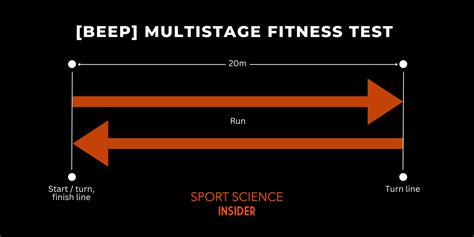The Nike Beep Test, also known as the 20-Meter Shuttle Run Test or the Multi-Stage Fitness Test, is a widely recognized assessment tool for measuring cardiovascular fitness. Developed by Luc Léger and R.A. Lambert in 1983, this test has gained popularity due to its simplicity, objectivity, and accessibility.

Understanding the Nike Beep Test
Procedure:
- Set up a 20-meter course marked with cones or other markers.
- Participants start the test standing behind the start line.
- Upon hearing a series of recorded beeps, participants run from one end of the course to the other, turn around, and run back.
- The speed of the beeps gradually increases as the test progresses.
- Participants continue until they can no longer keep pace with the beeps or are too exhausted to continue.
Assessment:
Participants’ performance is measured by the level (or stage) they reach before exhaustion. The level corresponds to the speed of the beeps at that point in the test.
Significance of the Nike Beep Test
The Nike Beep Test has become a valuable tool for assessing cardiovascular fitness in various settings:
- Sports: It helps coaches and athletes evaluate fitness levels and track progress.
- Military: The test is used for assessing the fitness of recruits and monitoring their training.
- Health and Fitness: Fitness professionals use the test to evaluate clients’ cardiovascular health and design personalized exercise programs.
- Research: The Nike Beep Test is employed in research studies to investigate the relationship between cardiovascular fitness and various health outcomes.
Key Findings
Numerous studies have demonstrated the accuracy and reliability of the Nike Beep Test. For example:
- A study published in the “Journal of Sports Sciences” found that the test had a high correlation with other measures of aerobic fitness, such as VO2 max.
- A study in the “British Journal of Sports Medicine” reported that the test could differentiate between individuals with different levels of cardiovascular fitness, including sedentary, moderately active, and highly active individuals.
Benefits of the Nike Beep Test
- Simplicity: The test requires minimal equipment and is easy to administer.
- Objectivity: The recorded beeps ensure that the test is impartial and consistent across participants.
- Relatively inexpensive: The test can be conducted with low-cost equipment, making it accessible to individuals and organizations with limited resources.
- Provides a comprehensive assessment: The test not only measures cardiovascular fitness but also provides insights into participants’ endurance and speed.
Limitations of the Nike Beep Test
- Can be demanding: The test is physically challenging and may not be suitable for individuals with certain health conditions or limitations.
- Relies on self-pacing: Participants may pace themselves differently, potentially affecting their results.
- Limited specificity: The test does not measure specific muscular strength or flexibility.
Beyond the Beep Test
While the Nike Beep Test remains a valuable assessment tool, researchers are exploring innovative applications:
- Cognitive Beep Test: This variation incorporates elements of cognitive challenges, such as memory and attention. It aims to assess the relationship between cardiovascular fitness and cognitive function.
- Interval Beep Test: This adaptation involves alternating periods of high-intensity running with rest or low-intensity running. It can be used to investigate fatigue resistance and recovery capacity.
- Agility Beep Test: This variation incorporates agility drills, such as lateral shuffles and cone-running, to evaluate agility and cardiovascular fitness simultaneously.
Step-by-Step Guide to Conducting the Nike Beep Test
- Prepare the Course: Set up a 20-meter course with cones or other markers.
- Brief Participants: Explain the test procedure and the importance of following the beeps.
- Warm-up: Lead participants through a light warm-up, such as jumping jacks or jogging.
- Start the Test: Instruct participants to line up behind the start line and begin the test.
- Monitor Progress: Observe participants’ performance and encourage them to continue as long as possible.
- Record Results: Note the level (or stage) that each participant reaches before exhaustion.
Training Implications
The Nike Beep Test can provide valuable information for training programs:
- Setting Goals: Test results can help individuals set realistic fitness goals and track their progress.
- Tailoring Programs: The test can inform the design of personalized training programs that focus on improving cardiovascular fitness.
- Monitoring Progress: Regular testing can monitor the effectiveness of training programs and identify any areas for adjustment.
Conclusion
The Nike Beep Test is a widely recognized and effective assessment tool for measuring cardiovascular fitness. Its simplicity, objectivity, and accessibility make it suitable for various settings. By understanding the significance, benefits, and limitations of the test, practitioners and individuals can utilize it effectively to assess and improve cardiovascular health. Ongoing research is exploring innovative applications, expanding the potential of the Nike Beep Test in the field of fitness assessment.
